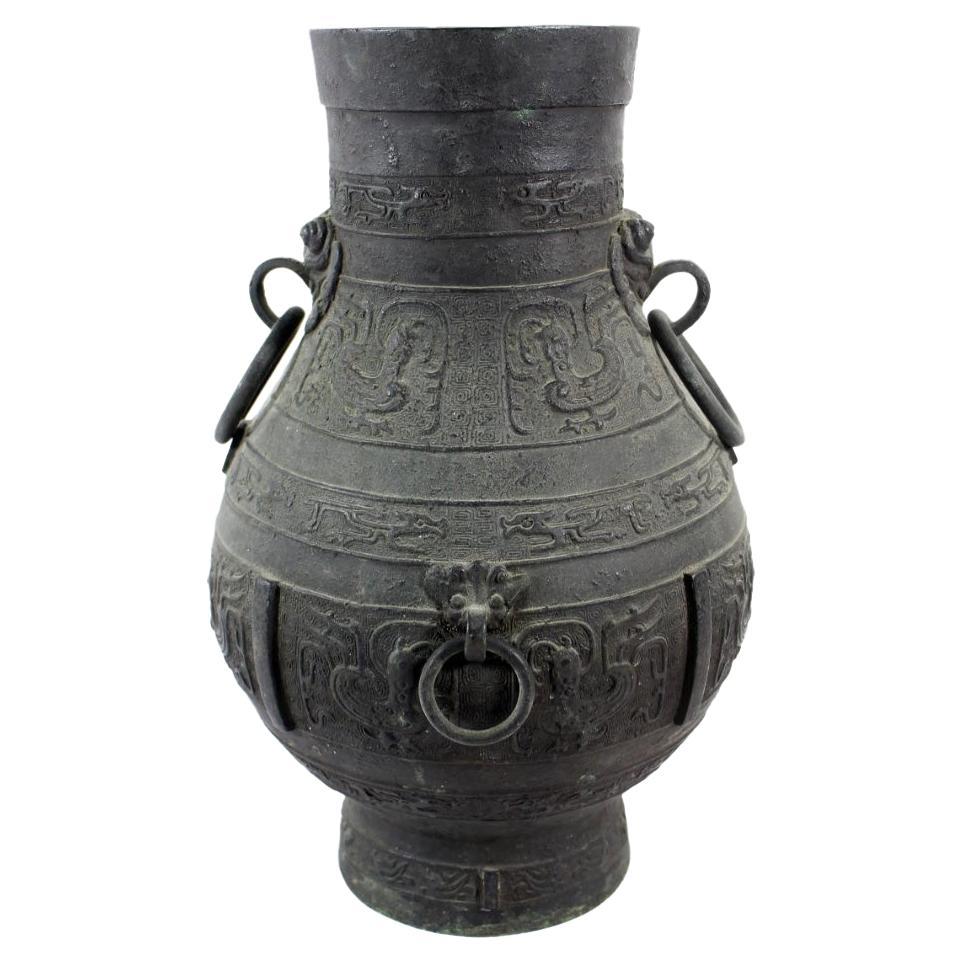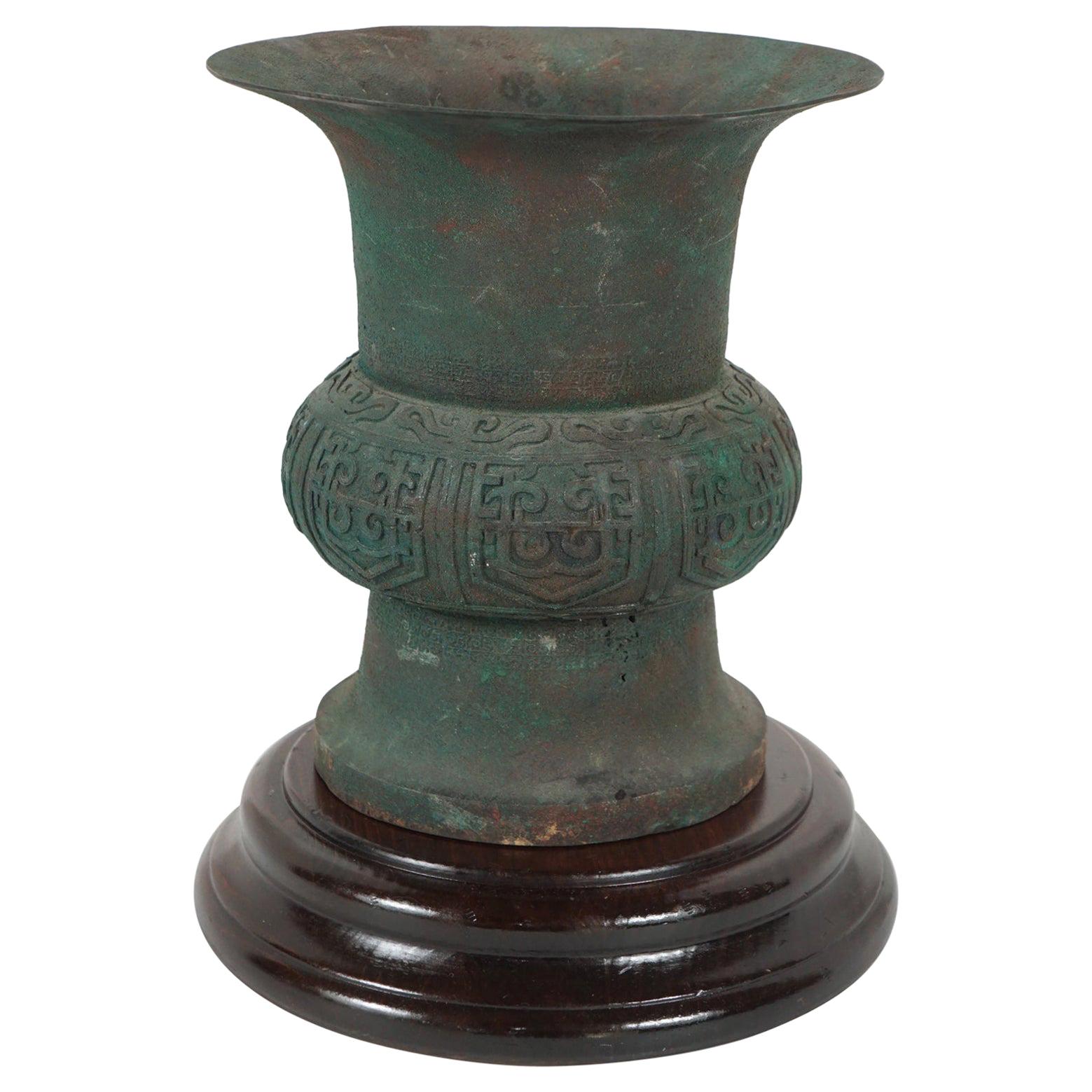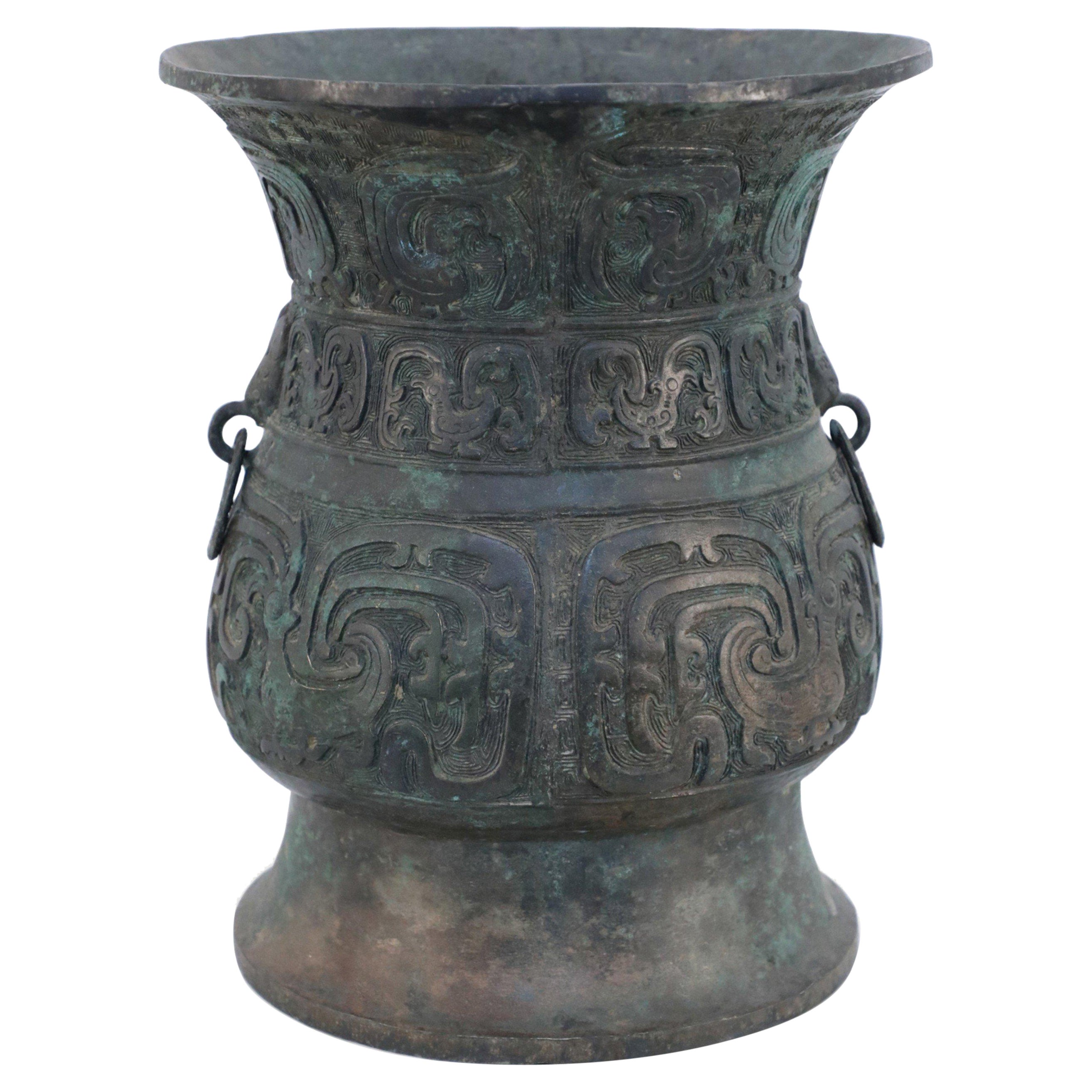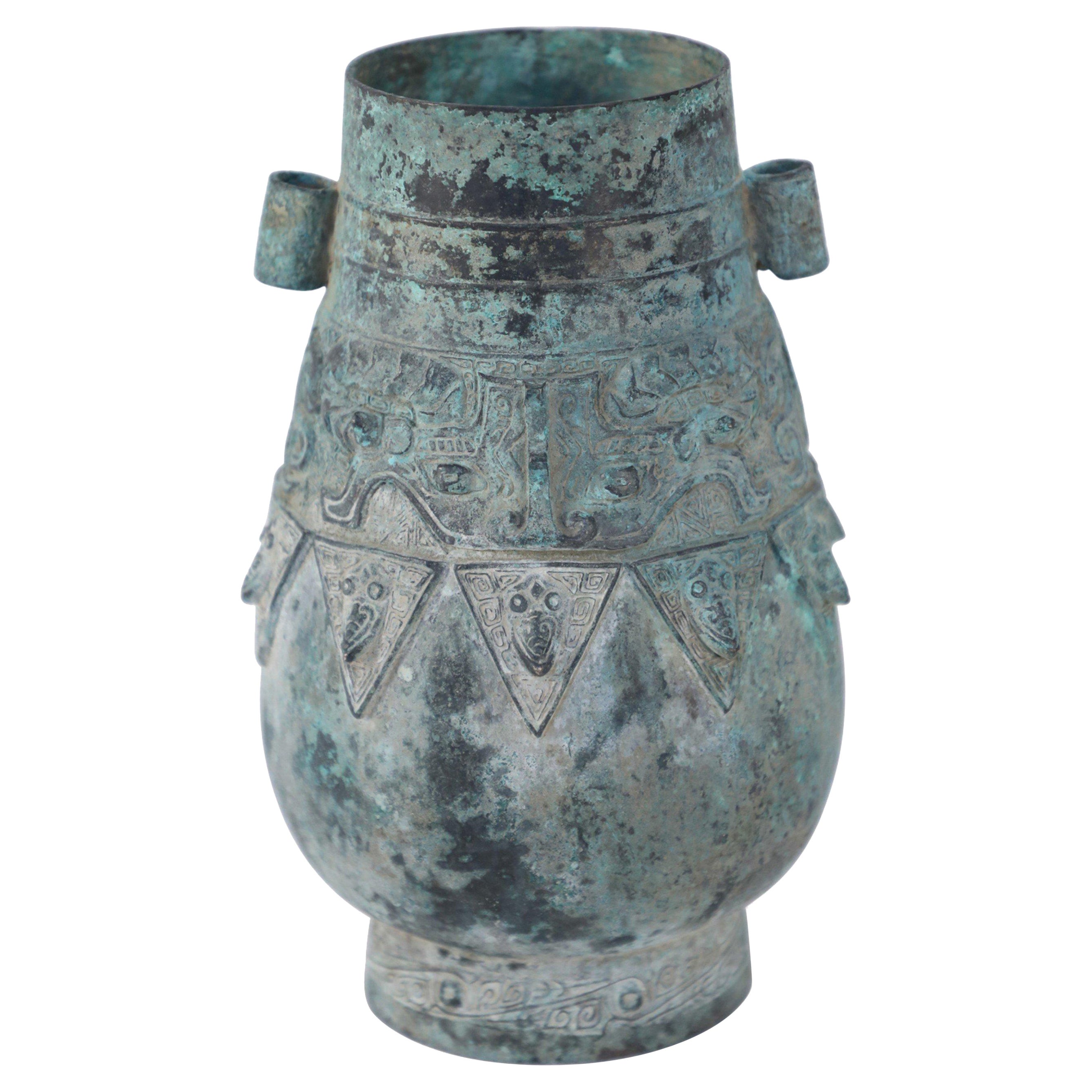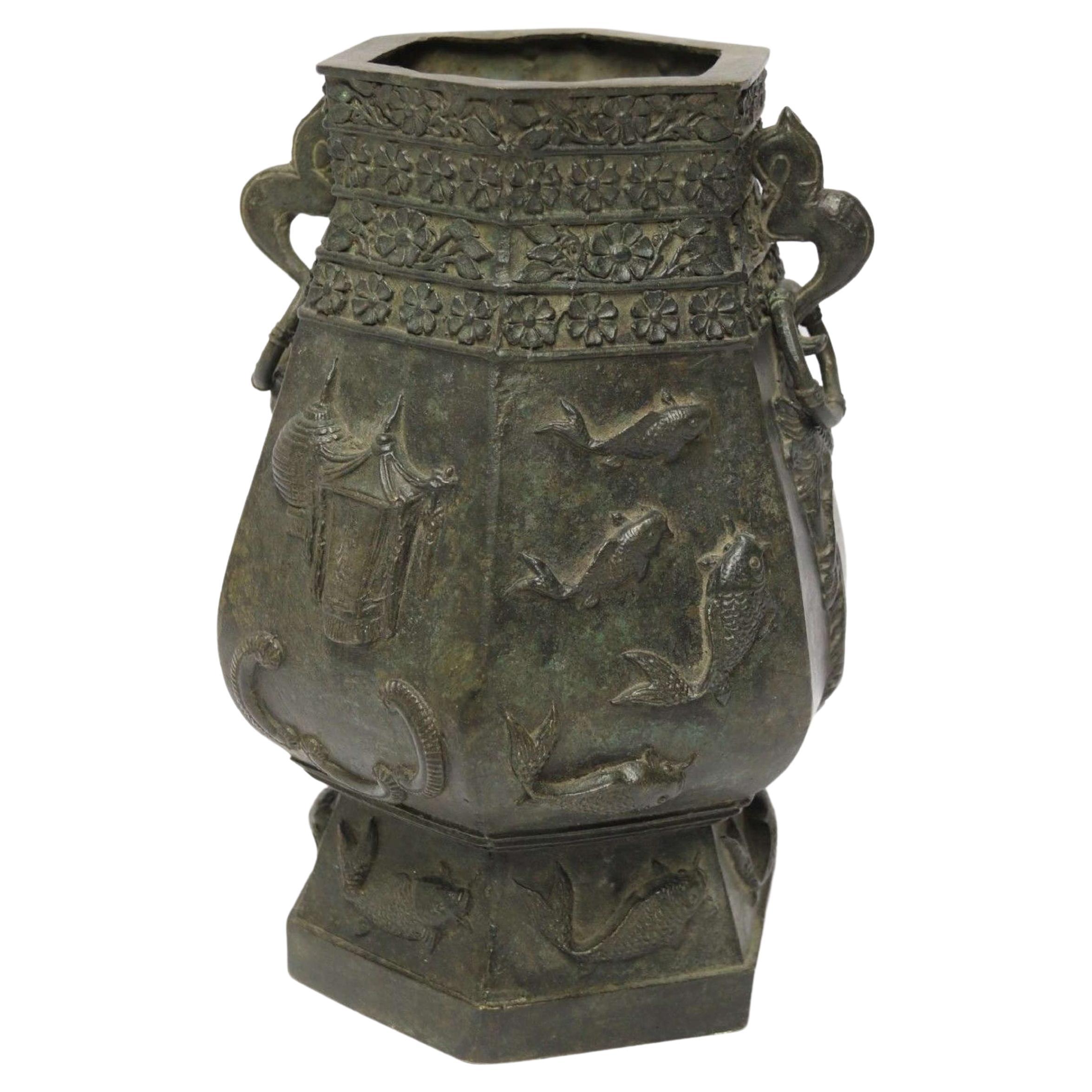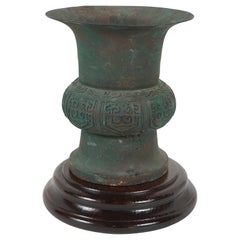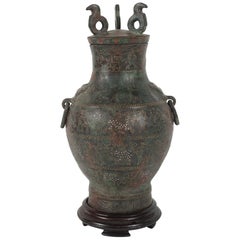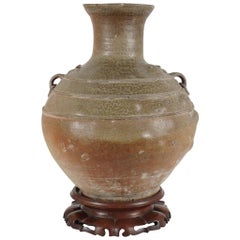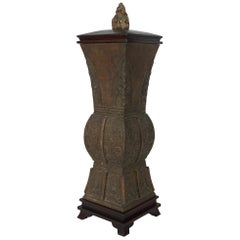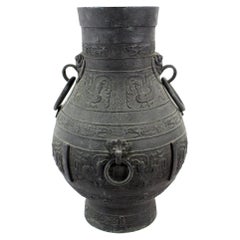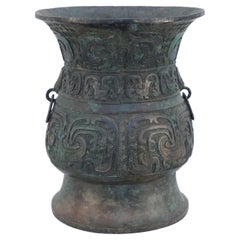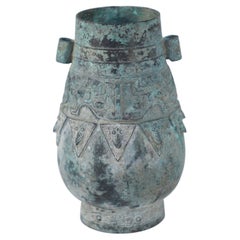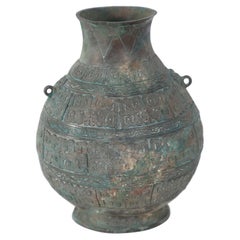Items Similar to Ming Dynasty Period Cast Bronze Hue Shaped Urn in an Archaist Style
Want more images or videos?
Request additional images or videos from the seller
1 of 7
Ming Dynasty Period Cast Bronze Hue Shaped Urn in an Archaist Style
$9,000
£6,833.91
€7,815.09
CA$12,574.31
A$13,985.37
CHF 7,302.73
MX$170,187.10
NOK 93,266.96
SEK 87,467.96
DKK 58,327.01
Shipping
Retrieving quote...The 1stDibs Promise:
Authenticity Guarantee,
Money-Back Guarantee,
24-Hour Cancellation
About the Item
This fine old urn cast as an honorific nod to the ancient past of China was made circa 1600-1650. The shape or Hue was a common and well-represented form in the Han dynasty in pottery and bronze. This urn shows thin casting to the walls with incorporated toe tia or facial masks that once might have held loose rings. The body of the urn is cast with ringed banded segments and has a further decorative element of a pyramidal shaped raised pattern border at the beginning of the neck. An interesting note is that the urns bottom is cast with a decorative crossed lattice pattern that we have never seen before (see photo 6). The entire surface of the body has a very subtle old patina and surface which remains untouched and original. The work comes with an old Chinese rosewood base. This urn was collected over 40 years ago and has remained in that collection in Virginia until we recently purchased the entire colletion after many years of attempts. We will be presenting the entire collection over the next few months.
- Dimensions:Height: 14 in (35.56 cm)Diameter: 13 in (33.02 cm)
- Style:Ming (Of the Period)
- Materials and Techniques:
- Place of Origin:
- Period:Mid-17th Century
- Date of Manufacture:1650
- Condition:Wear consistent with age and use.
- Seller Location:Hudson, NY
- Reference Number:1stDibs: LU811312650602
About the Seller
4.5
Vetted Professional Seller
Every seller passes strict standards for authenticity and reliability
Established in 1978
1stDibs seller since 2005
340 sales on 1stDibs
Typical response time: 19 hours
- ShippingRetrieving quote...Shipping from: Hudson, NY
- Return Policy
Authenticity Guarantee
In the unlikely event there’s an issue with an item’s authenticity, contact us within 1 year for a full refund. DetailsMoney-Back Guarantee
If your item is not as described, is damaged in transit, or does not arrive, contact us within 7 days for a full refund. Details24-Hour Cancellation
You have a 24-hour grace period in which to reconsider your purchase, with no questions asked.Vetted Professional Sellers
Our world-class sellers must adhere to strict standards for service and quality, maintaining the integrity of our listings.Price-Match Guarantee
If you find that a seller listed the same item for a lower price elsewhere, we’ll match it.Trusted Global Delivery
Our best-in-class carrier network provides specialized shipping options worldwide, including custom delivery.More From This Seller
View AllVery Late 18th-Early 19th Century Cast Bronze Chinese Archaistic Vessel
Located in Hudson, NY
This Chinese cast bronze urn was made to pay honor to the fine vessels produced in the Shang, Zhou and Han periods. This work cast in the late 18th into the early 19th century (circa...
Category
Antique 1790s Chinese Archaistic Metalwork
Materials
Bronze
Chinese Zhou Dynasty Style Bronze Hue Inlaid with Gold & Silver Wire
Located in Hudson, NY
This cast bronze vessel was made in China as an honorific presentation circa 1920. Cast in the style of the Zhou dynasty it would have been used ritually ...
Category
Early 20th Century Chinese Archaistic Metalwork
Materials
Bronze
Period Large Han Dynasty Green Glazed Large Jar on 19th Century Rosewood Stand
Located in Hudson, NY
This globular jar of a large size is traditionally called a Hu. Created in the Han dynasty and fully authenticated by the Chinese Government for the collective Group “Hong Kong Art C...
Category
Antique 15th Century and Earlier Chinese Ceramics
Materials
Pottery, Rosewood
Chinese Arcaistic Style Cast Bronze Lidded Urn with Carved Jade Finial
Located in Hudson, NY
This very finely cast bronze urn in an archaistic form was made in the very late 19th century approximately 1895-1900. Done with an apocryphal feeling to honor the ancient past, the vase is beautifully rendered in low relief in bronze covering almost the entire body of the urn. The predominant features are the divided taotie masks that compose the swelling middle body of the vase and also at the corners of the upper section. Crisp but subtle, the casting is clearly handled with great attention to linear form. The patina is very nice and consists of a modeled golden brown with a slight but very lite Verdigris color. The urn has an old rosewood base and lid that seems to have been purpose made for the object. Finally, the whole is set off with a carved jade finial...
Category
Early 20th Century Chinese Archaistic Metalwork
Materials
Jade, Bronze
Large Japanese Tokyo Bronze Vase
Located in Hudson, NY
This large and impressive cast bronze vase is of a type called Tokyo bronzes. It displays elements both of Japanese and Chinese iconography and is not onl...
Category
Antique 19th Century Japanese Metalwork
Materials
Bronze
Large Japanese Meiji Period Open Bronze Censor
Located in Hudson, NY
This cast bronze censor is from Japan and was made circa 1880. Raised up on three legs which issue from demons mouths the container is cast with reliefs ...
Category
Antique Late 19th Century Japanese Meiji Metalwork
Materials
Bronze
You May Also Like
Old Bronze Vessel
Located in Scottsdale, AZ
Unearth a piece of history with this captivating old bronze vessel, a treasure that speaks volumes of its rich past. Discovered and now presented for your consideration, this artifac...
Category
Early 20th Century Chinese Export Vases
Materials
Bronze
$1,595
Antique Chinese Han Dynasty Style Bronze Ritual Urn
Located in Queens, NY
Antique Chinese Han Dynasty-style verdigis bronze ritual urn with raised archaistic patterns wrapping its form and accented with small rings on two sides beneath the opening. Charact...
Category
20th Century Chinese Chinese Export Urns
Materials
Bronze
Chinese Han Dynasty-Style Patinated Bronze Urn
Located in Queens, NY
Antique Chinese Han Dynasty-style copy of a patinated bronze vase with a bulbous body decorated in raised geometric pattern bands, sitting atop a circular base, and accented with two...
Category
20th Century Chinese Chinese Export Vases
Materials
Bronze
Chinese Han Dynasty Style Patinated Bronze Carved Urn
Located in Queens, NY
Antique Chinese Han Dynasty-style copy patinaed bronze urn carved with raised geometric patterned bands wrapping its form and adorned with two small handles beneath the neck.
Category
20th Century Chinese Chinese Export Urns
Materials
Metal
Chinese Finely Cast 19th Century Bronze Vessel circa 1860
Located in Central England, GB
A Chinese Finely Cast 19th century bronze vessel
This bold and stylish Chinese shaped hexagonal vessel is heavily cast in solid bronze. It has a very pleasing shape which is enhan...
Category
Antique 19th Century Chinese Chinese Export Vases
Materials
Bronze
Japanese Bronze Vase Early 20th Century
Located in Meer, VAN
Tall Bronze Vase, Japan, Early 20th Century.
This is a very beautiful eared vase / urn in bronze from Japan. Probably early 20th century.
From a hig...
Category
Early 20th Century Japanese Japonisme Vases
Materials
Bronze
More Ways To Browse
Bronze Dynasty
Ancient Urn
Antique Chinese Rosewood
Ming Bronze
Antique Chinese Mask
Ming Dynasty Pottery
Ming Dynasty Bronze
Han Dynasty Bronze
Mid Century Bronze Pottery
Old Bronze Cross
Chinese Bronze Urn
Chinese Carved Mask
1600 Pottery
Antique Chinese Nodders
Rings 1600 Century
Chinese Ming Style Rosewood
Ming Dynasty Urn
Antique Rosewood Pottery
